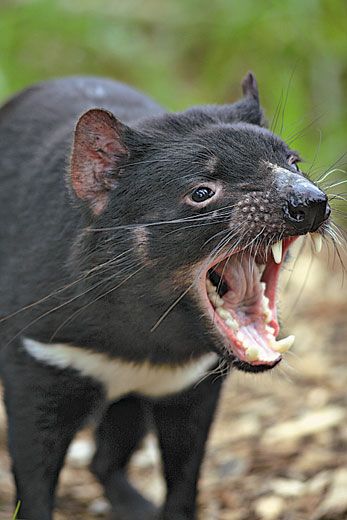What is Killing the Tasmanian Devil?
The island’s most famous inhabitant is under attack by a diabolical disease
Tasmanian devils are named for their chilling nocturnal shrieks, which reminded early colonists of hellhounds. Perhaps more than any other sound, the screams give a lone bush walker “this feeling of being in the wilderness,” says Elizabeth Murchison, a Tasmanian-born geneticist who studies the animals.
“But,” she adds, “it’s quite rare to hear them now.”
The squat black creatures are in the throes of an epidemic that has reduced their numbers by more than 80 percent across the island since the disease was detected in 1996. Once common, the world’s largest carnivorous marsupial is now endangered. The culprit is a contagious cancer that kills every animal it infects.
“I am concerned that we are documenting an extinction here,” says Vanessa Hayes, a geneticist from the J. Craig Venter Institute in San Diego, who has investigated the Devil Facial Tumor Disease. “No devil survives this.”
Flesh-and-blood devils bear little resemblance to Taz, the spasmodic Looney Tunes cartoon character. The size of small dogs, they look like a cross between black bears and weasels. When they are upset, their ears blush a furious crimson, resembling red horns and adding to their diabolical image. (Baby devils, packed four to a pouch, are known as imps.)
But the devils are actually shy rather than demonic, and they provide valuable custodial services, gobbling putrefied sheep, rotting wombat and whatever else is lying around. A devil has an outsize head, neck and jaw that together account for up to a quarter of its body weight, the better to crunch bones.
The animals are beloved on the island, the go-to mascot for sports teams and a symbol of all things Tasmanian. They were once scattered throughout mainland Australia, but dingoes, a type of domestic dog introduced by seafaring people, edged them out hundreds of years ago. Luckily, dingoes never made it to Tasmania. Yet living exclusively on this island refuge has limited the devils’ genetic diversity, making them vulnerable to disease.
When the disfiguring lumps and lesions on the devils’ heads first appeared, scientists thought the disease must be caused by a virus. But it is actually an aggressive cancer, and the contagious agents are the tumor cells themselves. An animal transmits the disease cells to another one by biting. Huge tumors quickly bloom in the new host, making eating impossible; some animals starve before the cancer starts shutting down their vital organs.
“It is undoubtedly one of the most successful cancer lineages that we know of,” says Murchison, of the Wellcome Trust Sanger Institute in Cambridge, England. Her team recently reported that the disease originated at least 16 years ago in a female devil; descendants of cells in her tumor live on in victims today.
The cancer doesn’t respond to chemotherapy, and even surgical removal of the tumors isn’t effective. Biologists have abandoned efforts to cull sick individuals from wild populations because the disease travels too fast. The government may fence off the one unscathed part of the island to protect the devils there, and uninfected “insurance populations” have been established on mainland Australia in case all the wild animals die.
The bedeviled animals’ best hope may be vaccines or genetic medicine.If scientists can learn which mutated genes are behind the cancer, they may be able to develop drugs to inhibit the activity of the tumor cells. But such a cure is years away, and if nothing changes the devils could go extinct within a few decades. “Will we make it in time?” says Janine Deakin, an Australian National University geneticist. “I don’t know.”
The disease may also add to biologists’ understanding of extinctions, which are typically blamed on factors such as hunting and habitat loss. Kristofer Helgen, a zoologist at the Smithsonian’s National Museum of Natural History, is studying an outbreak that may have struck the devils and an even bigger carnivorous marsupial, the Tasmanian tiger, a century ago.The tiger, inbred and overhunted, soon disappeared for good. That malady is probably unrelated to the modern cancer. But “in the span of a single century, we’ve seen two disease episodes severe enough to result in major declines,” Helgen says. “Disease may explain extinctions that would otherwise go unexplained. It may be one of the important things that causes the final blink-out.”
